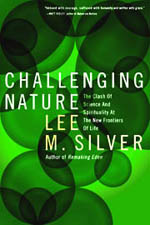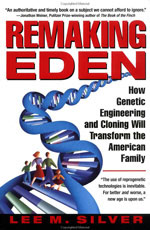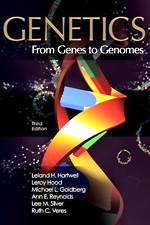|
published by Ecco/Harper Collins, 2006
|
|
Books
Presentations
Publications/Writings
Biography
Princeton Courses
|
A book review by Lee M. Silver
Science, Vol 287, Issue 5457, 1404-1405 , 25 February 2000
The Second Creation: The Age of Biological Control by the Scientists
Who Cloned Dolly by Ian Wilmut, Keith Campbell, and Colin Tudge)
Is there any literate adult in any of the world's industrialized countries
who has not heard of Dolly the cloned sheep? I doubt it. Since her debut just three years ago,
Dolly has been mentioned in over 4000 news articles in major U.S. newspapers and magazines alone
and in countless other news articles, radio broadcasts, and television programs around the globe.
She has also been the subject of at least 14 books published for a lay audience. Now the two
scientists most closely involved in Dolly's creation--Ian Wilmut and Keith Campbell--have added
their own book, The Second Creation, to this long list. With coauthor Colin Tudge, a highly respected
British science writer, translating their voices to prose, they provide an insider's account
of cloning at Scotland's Roslin Institute.
At the outset, Wilmut and Campbell tell us that all of Dolly's other popularizers
have misunderstood her importance. Dolly's true significance lies not in potential implications
for future human reproduction, but rather in improved methods for the production of transgenic
animals and other advances in biotechnology. These are the reasons, they tell us, that Dolly
should matter to ordinary people.
The first 124 pages of The Second Creation present the reader with a whirlwind
scientific and historical review of the biological disciplines that form the foundation for the
cloning research done by Wilmut and Campbell. Surveys of cell biology, developmental biology,
reproductive biology, and cytogenetics are presented along with more detailed descriptions of
mitosis, meiosis, oogenesis, and fertilization. There are brief forays into recombinant DNA technology,
molecular genetics, and the evolution of sex and sexual dimorphism. As Wilmut warns, the technical
language has not been "ducked." But it is not clear who this section was written for.
The coverage (lacking figures, footnotes, or bibliography) is too sketchy to satisfy biologists
and science scholars, who would be better served by appropriate textbooks. For nonscientists,
there is too much technical detail and jargon without relevance to cloning.
The text becomes more lively with each subsequent section. The authors offer
an overview of earlier cloning research, including the contested experiments of Karl Illmense,
the respected experiments of Davor Solter [who, in 1984, infamously declared that the cloning
of mammals was impossible (1)], and the important contribution of Steen Willadsen (actually the
first scientist to achieve success at mammalian cloning)--developments covered with detailed
citations by science journalist Gina Kolata in her book Clone (2).
After these discussions, Wilmut and Campbell reach the heart of their story:
autobiographical accounts of the events, ideas, and private thoughts that brought Wilmut (at
least) from obscurity to international fame. They explain that the original impetus behind their
research was the desire to develop an efficient method for producing transgenic farm animals.
Step by step, they march the reader through the logic of each critical experiment along the path
toward this goal.
Wilmut and Campbell began their experiments sharing the widely held assumption
that viable embryos could only be formed with donor nuclei transferred from totipotent cells.
But after an attempt to pinpoint the developmental stage at which cells lose their totipotency,
their research progressed to the question of whether the loss of totipotency mattered at all.
Campbell, in particular, felt that control over the cell cycle was more important to successful
cloning.
Scientific vindication of this heretical idea arrived with the 1995 birth
of Megan and Morag, two sheep created by nuclear transfer from clearly differentiated cultured
cells. Their existence destroyed the dogmatic belief in the irreversibility of mammalian cell
differentiation. At the same time, it demonstrated the feasibility of considering nuclear transfer
from genetically transformed cells in culture as a vastly improved method for genetic engineering
of large animals--the approach validated two years later with the birth of the genetically engineered
sheep Polly.
Wilmut and Campbell confess that they don't understand why Megan and Morag
are not as famous as Dolly. As Campbell says, "For me, Megan and Morag are the stars." To
be sure, upon publication in March 1996 (3), the Megan and Morag cloning report was picked up
by the British media and by many American papers as well. But, like nearly all stories of scientific
advances, it was essentially a onetime news event. Wilmut thinks it might have been otherwise
if the attention of the media had not been deflected by a horrible murder of British schoolchildren
that occurred seven days later.
The experiment that produced Dolly had no relevance to the technological
goals of the Roslin Institute. It was planned simply to complete the panel of developmental stages
tested for competency in cloning. To Wilmut and Campbell, Dolly is merely the "gilt on the
gingerbread." Kolata reports that Wilmut originally thought "the interest in Dolly
might be somewhat less than the interest had been in Megan and Morag" (2, p. 222).
Why was Wilmut's prediction so far off the mark? Ironically, Dolly's true
significance lies within an implication that her creators wish did not exist: Dolly is living
proof that the genetic cloning of adult human beings is no longer in the realm of the impossible.
Even more ironically, Dolly is most significant by far to the billions of
people who least understand her. Around the globe, her image was splashed across television screens
interspersed with footage from films of Boys from Brazil, Frankenstein, Brave New World, and
Multiplicity. Instantly, Dolly's public fame emerged not from what she really is, but from what
she represents. She is a metaphor for the Promethean power that scientists now have to create
and control life, and her innocent image drives fear into the hearts of those who think man has
wrongly crossed into God's domain.
Although the title of The Second Creation is an echo of the metaphorical
Dolly, in their text the authors try hard to bring readers back down to the real-life version.
They end their story with an overview of the many benefits that humankind may derive from the
biotechnology facilitated by genetic cloning. This section, at the very least, should be required
reading for societal leaders who still mistake metaphor for reality in the promulgation of anti-cloning
laws.
References
1. J. McGrath and D. Solter, Science 266, 1317 (1984).
2. G. Kolata, Clone: The Road to Dolly and the Path Ahead (Morrow, New York, 1998). 3. K. H. S. Campbell, J. McWhir, W. A. Ritchie, I. Wilmut, Nature 380, 64 (1996). The author is in the Department of Molecular Biology and the Woodrow Wilson School of Public and International Affairs, Princeton University, Princeton, NJ 08544, USA. E-mail: [email protected] |
Hover over or click on books to order from Amazon.com
|



